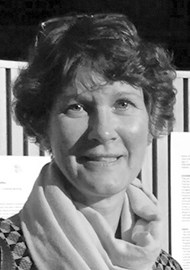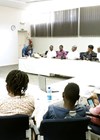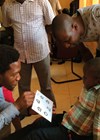Screening for diabetic retinopathy prevents blindness. There is no systematic screening programme for diabetic eye disease in Malawi and people present when they have lost vision and it is too late for treatment.
The aim of the VISION 2020 LINK between Malawi and Queen Margaret Hospital, Fife and Princess Alexandra Eye Pavilion (PAEP), Edinburgh is to develop capacity for screening and treatment for diabetic retinopathy (DR).

Teaching team of the 2019 Diabetic Retinopathy Screening Workshop in Lilongwe.
Most recent figures put the population of Malawi at just over 18 million. The number of consultant ophthalmologists working in Malawi is gradually growing following the development of a training centre in Blantyre, but this number has only risen to eight. This is in contrast to NHS Fife, which has the same number of consultant ophthalmologists for a population of less than 400,000 people.
We therefore identified the need for training of other cadres within Malawi to manage the workload. To achieve this, the Fife team developed and delivered a teaching programme for healthcare professionals working across all regions of Malawi. This teaching programme began in 2015 and over the five annual visits to date we have taught 206 ophthalmic clinical officers (OCOs), ophthalmic technicians (OTs), nurses and optometrists.
This builds on a long-standing LINK partnership between PAEP, Edinburgh, with Malawi that was established in 2007 and continues to support the partnership. The LINK has benefitted from a five-year grant from the Queen Elizabeth Diamond Jubilee Trust [1] to the London School of Hygiene & Tropical Medicine. It has also benefitted from funding from the Scottish Government [2].
Malawi-Fife LINK training visit 2019
This year our training visit in April had 64 new participants attending the course and providing feedback. There were 18 OCOs, 26 OTs, 15 optometrists, four nurses and one OCO / cataract surgeon. One OCO who had previously attended the course was also present. Participants came from all regions of Malawi, including the far northern border with Tanzania.
The teaching team was composed of eye health professionals from Malawi and Scotland:
Fife / Edinburgh team:
- Dr Caroline Styles (Consultant Ophthalmologist, Fife and lead clinician for DR Screening, DRS Scotland)
- Dr Anne Sinclair (Associate Specialist, Fife)
- Dr Roxanne Annoh (Specialist Registrar, PAEP, Edinburgh)
- Ms Lynsey Scott (Senior Grader for DRS Fife)
- Dr Martin Anderson (Specialist Registrar, PAEP, Edinburgh)
Malawi team:
- Dr Joseph Msosa (Consultant Ophthalmologist, Lilongwe)
- Dr Moira Gandiwa (Ophthalmologist, Blantyre)
- Dr Shaffi Mdala (Ophthalmologist, Blantyre)
- Dr Thoko Zungu (Ophthalmology Registrar, Blantyre)
- Dr Esther Misanjo (Ophthalmology Registrar, Blantyre)
- Dr Patty Mopamboli (Consultant Ophthalmologist, Mzuzu)
Learning objectives for the course
The learning objectives were:
- Understand why screening is important
- Know how to screen
- Recognise features of DR
- Discuss the result and outcome of screening with a patient and provide appropriate advice
- Give advice to patients on healthy lifestyle in diabetes and on other possible complications
- To understand the management options for sight-threatening DR
- Update of grading skills and referral protocols for DR using fundus photography (for graders only)
- Plan how to prevent one extra person per week going blind from diabetes in Malawi.
Course programme
The three-day course consisted of lectures and small group teaching sessions (with all of the teaching team leading groups). All delegates were provided with Arclight ophthalmoscopes to use as a tool for screening. The first two days included a session for examination of patients using the Arclight and slit-lamps (see timetable).
Teaching material was provided for each delegate including handouts from lectures, Arclight instruction page and laminated DR referral guideline posters for local clinic rooms.


Lectures on the treatment of diabetic eye disease by Dr Anderson and Dr Annoh.

Delegates in small group teaching sessions on DR classification.

Lecture on pathophysiology of diabetes by Dr Ngoma.

Diabetic patient education by Olive and Martha.
Main lectures
Diabetic retinopathy screening in Malawi; past, present and future
Moira Gandiwa presented the programmes currently running at the two main hospitals in Malawi – Lilongwe and Blantyre. We discussed the process required to set up screening in the hospitals emphasising that the aim of this teaching course was for participants to commit to setting up screening services at their home institution.
Features of diabetic eye disease
Anne Sinclair introduced the delegates to the retinal features seen in diabetic eye disease and how to identify them. The delegates were taught what grade of retinopathy this represents and therefore the risk of developing sight-threatening diabetic eye disease. The adapted grading scheme based on International Council of Ophthalmology guidance was introduced. This had been altered to allow for the available resources in Malawi following feedback from last year’s course and discussion with the two medical retina specialists in Malawi.
Diabetes
A local consultant physician (Dr Jonathan Ngoma) informed the group of the pathophysiology and management of diabetes so that they are aware of other complications that can arise from this systemic disease. Delegates felt that they had gained a much better understanding of the condition and the importance of lifestyle management advice to patients.
Diabetic maculopathy
Caroline Styles introduced features and classification of diabetic maculopathy. There was emphasis on features and management of sight-threatening maculopathy and the use of intravitreal injections in centre-involving macular disease.
Patient education
Olive is a retired nurse who delivers patient health talks before every diabetes clinic in Lilongwe. She taught the delegates about diet, hypoglycaemia, control of blood sugar and complications of diabetes in an interactive way. Malawi has an active patient association and patient volunteer Martha spoke passionately to the group about how she manages her diabetes and what it is like to live with a chronic disease. Many of the delegates reported that they feel able to give health talks to their church groups and diabetes clinics as a result of this training, which will raise awareness of diabetes and the eye complications in the community.
Treatment of diabetic eye disease
Many delegates work vast distances away from the main hospitals, therefore it is important that, if they identify a person who requires treatment for their diabetic eye disease, they can explain what treatment will involve. Rozanne Annoh and Martin Anderson therefore delivered a lecture on treatment of sight-threatening diabetic eye disease, including laser treatment, intravitreal injection therapy and surgery. The talk was followed by a visit to the laser room at Kamuzu Central Hospital so that the delegates are able to counsel their patients about treatment and reduce non-attendance for this important treatment. Delegates also had an opportunity to visit the fundus camera and have photos of their retina to see how the equipment is used for DR screening.
Small group teaching
(i) Examination of patients / simulated eyes
All delegates had the opportunity to examine patients with diabetic eye disease using the Arclight and / or slit-lamp microscope. They were also provided with simulated eyes with different stages of DR, enabling them to classify accordingly and highlight whether they would refer or monitor.
(ii) Group discussions
We split into eight groups to look at a series of retinal photographs and cards to examine and discuss grade of retinopathy, whether to refer to hospital, and how to discuss the outcome with the person. We presented a series of scenarios to use in discussions to raise awareness of how diabetes affects different age groups and emphasised pregnancy as a group to be screened. We also explained the legal implications for driving in patients with sight-threatening DR.
Grading DR with fundus photography
In Malawi, camera screening and grading is available in the three main centres – Lilongwe, Blantyre and Mzuzu – where laser treatment is also provided. The screener / graders in these centres had each undergone training in the past, but a need for updating of knowledge and practice was identified. Lynsey Scott, Senior Grader with Fife DRS, supported by Anne Sinclair, held small group teaching sessions with four OCOs / OTs in using fundus photography for grading DR.
After assessing the learning needs of the group:
a) The delegates had a clinical update on grading skills in line with the international classification scheme. Emphasis was made on applying DRS grading standards in line with local agreed standards. The importance of sensitivity and specificity in relation to referrals was backed up by the development of a Standard Operating Procedure. This was jointly developed by Lynsey and the graders, and will be disseminated to those who had been unable to attend in person.
b) The Malawian graders are now establishing a network so that they can share their knowledge and experience.
c) Data collection by the graders was discussed and, together with Lynsey, they produced a new data set that will enable them to audit their referrals more easily.


Lynsey Scott and delegates with the fundus camera.
Course assessment
All participants undertook a written assessment to ensure they had absorbed the relevant information from the course. We were pleased to see that everybody passed, with the vast majority achieving scores of 85% or higher. Three delegates achieved full marks (100%) and were awarded prizes for their efforts. Four more delegates achieved scores of ≥98% and were awarded runner-up prizes.
Feedback
The responses of the delegates were as follows:
- 100% of delegates were confident in using the Arclight ophthalmoscope independently for screening, of whom 72% were confident enough to teach others how to use the device
- 100% of delegates were confident in recognising the features of DR, of whom 59% were confident enough to teach others
- 98% were confident in discussing with patients why eye screening isimportant
- 96% were confident regarding what to do when diabetic retinopathy is detected
- 96% were confident to discuss the results of screening with patients and the treatment they may require
- 93% were confident in understanding the general principles of good diabetes care and would be able to explain this to patients
- 91% understood the importance of DR screening in Malawi and their role in implementing this in their regions.
More general feedback on the training course is summarised in the chart above.
We asked the participants how they would change their practice in the future. This prompted discussion about how to develop screening services within the local community, how to educate colleagues and, importantly, how to educate communities about the risk diabetes has on sight. We provided delegates within each region with a comprehensive logbook, to enable documentation of all patients screened, the diagnosis made and the referrals onto secondary care, for data collection.
See the table below.

“100% of delegates were confident in using the Arclight ophthalmoscope independently for screening”
Comments from course delegates
Examples of feedback on the course are:
- “The presentations were simple and clear to understand, the training has been so great with positive impact, I’m hoping to see DR screening implemented in all districts across Malawi. I will take part to support this initiative.”
- “It has been a good experience for we have learned a lot of things and it made me confident to screen diabetic patients.“
- “This has been a better opportunity for me to learn something I did not know. More trainings like these, then we will be able to help prevent diabetic patients from going blind.”
- “I am very thankful to the organisers of this meeting because it is the basis for the prevention of vision loss in patients with diabetes.”
- “Need more equipment, e.g. 78D lens, also dilating drops at Lilongwe DHO (this hospital has no slit-lamp).”
- “I will introduce a screening programme at my church for diabetes because I have all the equipment.”
- “To have thorough screening, we will need a 90D lens, which we are lacking. I have enjoyed this training very much (lens provided).”
- “Next time, we should have a brief introduction to anatomy for those who have no basic knowledge in ophthalmology.”
Examples of suggestions for the future are:
- “There should be periodic online refresher or other DR-related materials sent to our emails.”
- “This training should be done again in the near future so that we can be given a chance to present the data based on how many diabetes patients are screened and other experiences we have encountered.”
- “Training was helpful and should be done frequently in order to keep reducing the problems of people who go blind due to DR.”
Certification
All the participants who completed the course, passed the assessment and gave feedback were awarded a certificate to recognise their hard work.
Results
Over the five-year teaching programme, we have trained every OCO in Malawi in DR screening. This will no doubt help to identify sight-threatening disease early enough to be treated successfully. We envision that this will strengthen screening across the country and help with obtaining regional documentation of patients screened and referred using the logbooks. This will help with data collection on the number of patients screened within each district and the number of patients referred to and / or treated in the three main hospitals.
References
1. The Queen Elizabeth Diamond Jubilee Trust:
https://www.jubileetribute.org
2. International Development. Scottish Government:
https://www.gov.scot/policies/international-development/

The 2019 course participants displaying their certificates alongside the teaching staff.
Correspondence: Marcia Zondervan, VISION 2020 LINKS Programme Manager, International Centre for Eye Health, LSHTM, Keppel Street, London, WC1E 7HT.
E: marcia.zondervan@lshtm.ac.uk
http://iceh.lshtm.ac.uk

COMMENTS ARE WELCOME













